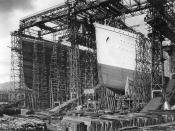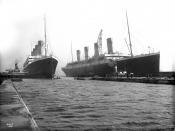The Building of the Titanic
The Titanic was a passenger ship that made its first voyage in 1912. This would also be its last voyage. It was designed to be one of the biggest and grandest ships of all time. Many people deemed the ship unsinkable. Most people know about the devastating disaster that this famous ship encountered. Few people know about the background and building of the huge vessel.
The Titanic began as an idea conceived at a dinner party. In 1907 a dinner party was held at Lord Pirrie's large Victorian mansion situated in the heart of Belgrade square in London (McCluskie).He was the chairman of Harland & Wolff shipbuilders. Also in attendance at this dinner party was the director of the Whitestar lines. This was a company who owned and operated many cruise ships. After the dinner party the men retired to the parlor where they came up with plans to build three huge and elaborate passenger ships.
The first would be the Olympic, second the Titanic, and third the Gigantic (Brewster).
The plan for the Titanic was for it to be the largest and most luxurious ship to ever be built. The Titanic was 882.5 ft. long. That is the length of 4 city blocks. The ships width of 92.5 feet was that equivalent to a four lane highway. The vessel had nine decks which made it as tall as an 11 story building. It weighed 53,000 tons. The total construction cost was 7.5 million dollars. At today's money value that would be 123 million dollars (Eaton). This project was funded by the wealthy American who owned White Star Lines. His name was J. P. Morgan.
The building of the Titanic took place at one of the largest shipyards in the world, Harland and Wolfe, in Belfast, Ireland. To take on the task of constructing such massive ships, the yards slips had to be modified. Three of the old slips would be widened and raised to 220 feet high. This would allow a place to construct two of the three ships. It took 15,000 Irish shipyard workers to build the two ships. They were paid ten dollars per week. This was a good average wage of the times (Brewster).
The Titanic's hull was made of 1 inch steal plates that overlapped each other. They were held together by more than 3 million rivets. The rivets were 3 inches long and 1 inch thick. A worker called a "heater boy" would heat a rivet until it was red hot. He would then throw it to the "catch boy" who caught it in a wooded bowl and placed it into a hole in the hull with a pair of tongs. While the "holder up" held a mallet over the rivets head on the out side of the hull, the "basher" on the inside of the hull would bash the rivets end into place. The steel hull weighted twenty-six thousand pounds (Stephens).
As a safety feature, the ship was to be built with a double bottom. The bottom was then divided into sixteen water tight compartments. This was designed to allow the ship to stay afloat with any two of the middle compartments, or four of the first compartments, flooded. It was thought that even the worst collision would damage no more than two compartments. This led many to believe the Titanic was unsinkable (Eaton).
The ship had three anchors. One anchor was placed on each side of the ships bow. These two anchors weighed almost 8 tons apiece. The third anchor was a center anchor that was stowed on the bow deck. This anchor weighed fifteen and one half tons. It took a team of twenty horses to pull the huge anchor into the shipyard. The total weight of all three anchors was more than the total weight of twenty cars ( McCluskie).
Once the ships hull was completed the ship needed to be moved to another location to be finished. On May 13, 1911 the Titanic would be launched. At this point all that the ship consists of was just an empty hull. More than 100,000 people crowed into the Harland & Wolff shipyard and stood along the banks of the River Lagan to watch the giant ship being moved into the water. At the time of the Titanic launch, it was said to be the largest man made object ever moved (Stephens). To accomplish this task the ship was built on a 772 foot long platform that sloped gently down to the water. The platforms were then greased with 22 tons of tallow, soap, and train oil. The big post holding the ship up, were then knocked away, leaving it held in place with mechanical triggers. When Lord Pirrie gave the signal to launch the ship, the triggers were released by the pulling of a handle that opened a valve. The ship would then slide down the wooden platforms into the river. This launch process took sixty-two seconds. Once it was in the water tug boats towed it to the outfitting basin (McCluskie).
The Titanic was place in a birth to be fitted out. This term means that every thing that was needed to make the ship ready for its first voyage would be done. This task consisted of everything from adding the top deck and funnels to making sure the kitchens had enough pots and pans. Grand stairways and elaborate interiors were also made at this time. Lifeboats were also placed on the ship during this fitting out procedure. The original plans were to have 64 lifeboats on board the ship. The number of boats placed on the ship was reduced to 32 then 16. This was to allow more deck room. Later 4 lifeboats with collapsible canvas sides were added (Brewster). This fitting out process took 10 months.
The first things to be installed were the 29 boilers, the huge reciprocating engines, and the turbine. To make the ship run, coal was used to heat water in the boilers. The boilers made high pressure steam that ran the two reciprocating engines. Those engines turned the two side propellers. The leftover steam from the two engines ran a turbine that turned the center propeller. The steam then ran to condensers that turned it back into water. The pumps sent the condensed water back to the boilers. Using this process to power the ship would require 620 to 640 tons of coal per day (Eaton).
To run the Titanics lights, phones, machinery, and heating systems, there was a generating plant powered by steam from the boilers. It took two hundred miles of electric cable to wire the ship. There was also a switchboard on the ship that controlled the fifty phones aboard. The ships crew could talk to one another on telephones located in the wheel house, forecastle, crows nest, engine room, poop deck, chief engineers' cabin, stokeholds, and kitchen areas. Some of the first class state rooms also had phones. None of these phones could be used to talk to any one on land. Messages to land had to be sent by telegraph (Stephens).
The interior of the ship was designed on a very elaborate scale. Through out the ship were beautiful wood carvings and the finest furnishings available. The first class lounge was said to be the grandest of all the rooms. It was decorated to look like the palace of Versailles. This was the first ship to have a pool on board. For 25 cents first class passengers could use this amenity (McCluskie). Many other extras included were shuffle board, rowing machines, mechanical horse, stationary bikes, a gym and a Turkish bath (Eaton).
The Titanic set sail on its maiden voyage with almost 1500 people aboard. This trip across the icy sea came about to be the first and last voyage of this grand unsinkable ship. On April 14, 1912 at around 11:40 pm the Titanic struck an iceberg. About two and a half hours later it sunk to the bottom of the extremely cold 28 degree ocean. Many lives were lost because there were not enough life boats to accommodate all the passengers. The people in the water did not survive the cold temperature. Most died of hypothermia after being in the water for only about 20 minutes (Brewster).
The grand plans that came about at a dinner party of 3 magnificent ships ended in disaster. The third ship that was to be named the Gigantic was never built. Due to the Titanics tragic loss, ships are now required to have enough lifeboats to carry 25 percent more people than the total number of passengers and crew on board a ship. As of today the unsinkable ship still rest on the bottom of the ocean floor.



Titanic
You have written a very informative essay. I'd just like to briefly comment about your concluding remarks. It is tragic that the ship did not carry a sufficient number of lifeboats out of a concern that they would make the decks look too cluttered. Aesthetics can be important, but surely not more so than human life. I sometimes wonder if the Titanic disaster wasn't preordained in order to remind us of human vanity and folly.
7 out of 7 people found this comment useful.